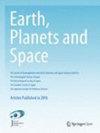Simultaneous observations of equatorial plasma bubbles with an all-sky airglow imager and a HF Doppler sounding system in Taiwan
IF 2.5
3区 地球科学
引用次数: 0
Abstract
Abstract High-Frequency Doppler (HFD) sounders at low-latitudes often detect characteristic oblique spreading Doppler traces in the spectrogram, known as Oblique Spread Structure (OSS). OSS has been expected to be generated by the dispersion of radio wave reflection due to equatorial plasma bubbles (EPBs). However, it has not yet been confirmed whether OSS is surely a manifestation of EPB by conducting simultaneous observations of EPB and OSS with different observational techniques. Additionally, it remains unclear what kinds of properties of EPB are reflected in the fine structure of OSS. In this study, we investigated three cases of OSSs and EPBs simultaneously observed by a HFD sounding system and an all-sky airglow imager in Taiwan. For the three cases presented here, the timing of OSS occurrence in the HFD data well coincided with that of the EPB appearance in the airglow data. The frequency shift of OSS is quantitatively explained assuming a radio wave reflection at 250–300 km altitudes. These results strongly indicate that OSS is formed by electron density variations at F-region altitudes accompanying EPB; thus, OSS is a manifestation of EPB in the HFD observations. Furthermore, it was suggested that the fine structure of OSS reflected the branching structure of EPB when the multiple branches of EPB reached the intermediate reflection point of the HFD observation. The detection of EPB occurrence and its fine structure using HFD observation enables monitoring of EPB regardless of weather conditions, which will contribute to monitoring the space weather impact of EPBs, for example, on GNSS navigation, in a wide area. Graphical Abstract用全天空气辉成像仪与高频多普勒探空系统在台湾同步观测赤道等离子体气泡
低纬度地区的高频多普勒(HFD)测深仪经常在频谱图中探测到特征的斜扩频多普勒迹,即斜扩频结构(OSS)。OSS被认为是由赤道等离子体气泡(EPBs)引起的无线电波反射色散产生的。然而,通过使用不同的观测技术同时观测EPB和OSS,尚未证实OSS是否一定是EPB的一种表现。此外,EPB的哪些特性在OSS的精细结构中得到了体现,目前还不清楚。本研究利用HFD探空系统与全天空气辉成像仪在台湾地区同时观测到3例OSSs与EPBs。对于本文提出的三个病例,HFD数据中OSS出现的时间与气辉数据中EPB出现的时间很好地吻合。假设无线电波在250-300公里高度反射,可以定量解释OSS的频移。这些结果强烈表明,OSS是由伴随EPB的f区高度的电子密度变化形成的;因此,OSS是EPB在HFD观测中的表现。进一步说明,当EPB的多个分支到达HFD观测的中间反射点时,OSS的精细结构反映了EPB的分支结构。利用HFD观测探测EPB的发生及其精细结构,可以在任何天气条件下对EPB进行监测,这将有助于监测EPB在大范围内对GNSS导航等空间天气的影响。图形抽象
本文章由计算机程序翻译,如有差异,请以英文原文为准。
求助全文
约1分钟内获得全文
求助全文
来源期刊

Earth, Planets and Space
地学天文-地球科学综合
CiteScore
5.80
自引率
16.70%
发文量
167
期刊介绍:
Earth, Planets and Space (EPS) covers scientific articles in Earth and Planetary Sciences, particularly geomagnetism, aeronomy, space science, seismology, volcanology, geodesy, and planetary science. EPS also welcomes articles in new and interdisciplinary subjects, including instrumentations. Only new and original contents will be accepted for publication.
 求助内容:
求助内容: 应助结果提醒方式:
应助结果提醒方式:


